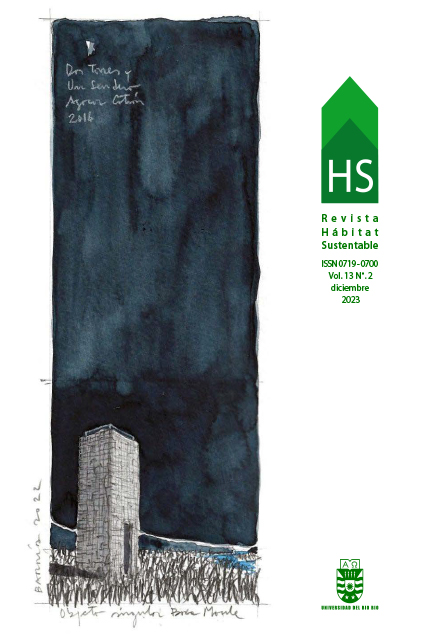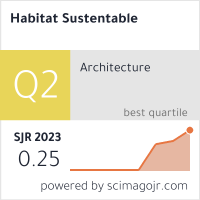Diseño bioclimático de vivienda media en la época del auge petrolero en Tampico, México (1912-1930)
DOI:
https://doi.org/10.22320/07190700.2023.13.02.07Palabras clave:
arquitectura bioclimática, clima cálido-húmedo, vivienda, sistemas pasivos, flujo de vientoResumen
El presente trabajo tiene por objetivo determinar estrategias bioclimáticas adecuadas para el clima de Tampico y comprobar si fueron aplicadas en la vivienda media construida en la época del auge petrolero en la ciudad. Mediante la caracterización climática de Tampico y la revisión de recomendaciones realizadas por autores de arquitectura bioclimática, se establecen las estrategias aplicables al clima local. Se realiza un catálogo de viviendas de la época con características bioclimáticas, obteniéndose acceso a cinco. Mediante entrevistas a los usuarios, se buscó conocer su percepción sobre el confort interior y para profundizar, se estudiaron exhaustivamente las viviendas en cuanto a la existencia o no de estrategias bioclimáticas. Se concluye que dichas viviendas sí cuentan con estrategias bioclimáticas adecuadas para el clima y que eran las mismas que las utilizadas en las viviendas de la época de referencia (auge petrolero) y que han ayudado en la mejora del confort interior de los edificios. Utilizarlas actualmente ayudará a minorar el calentamiento interior, el uso excesivo de energías no renovables y los altos costos por consumo energético.
Descargas
Citas
AHMED, T., KUMAR, P., & MOTTET, L. (2021). Natural ventilation in warm climates: The challenges of thermal comfort, heatwave resilience and indoor air quality. Renewable and Sustainable Energy Reviews, 138, 110669. https://doi.org/10.1016/J.RSER.2020.110669
AULICIEMS, A. (1981). Towards a psycho-physiological model of thermal perception. International Journal of Biometeorology, 25(2), 109-122. https://doi.org/10.1007/BF02184458
BARTORILA, M. Á., & LOREDO, R. I. (2017). La Industria Petrolera y la Modernidad: Transformaciones Urbanas en Tampico-Madero, Tamaulipas, México. CONTEXTO. Revista De La Facultad De Arquitectura De La Universidad Autónoma De Nuevo León, 11(14), 43–61. https://contexto.uanl.mx/index.php/contexto/article/view/63
BELTRÁN-FERNÁNDEZ, M., GARCÍA-MUÑOZ, J., & DUFRASNES, E. (2017). Analysis of the bioclimatic strategies used by Frank Lloyd Wright in the Jacobs I house. Informes de la Construccion, 69(547), 213. https://doi.org/10.3989/ic.16.156
CRUZ-RICO, J., RIVAS, D., & TEJEDA-MARTÍNEZ, A. (2015). Variability of surface air temperature in Tampico, northeastern Mexico. International Journal of Climatology, 35(11), 3220–3228. https://doi.org/10.1002/joc.4200
DE DEAR, R. (2004). Thermal comfort in practice. Indoor Air, (14, s7), 23-39. https://doi.org/10.1111/j.1600-0668.2004.00270.x
GAYTAN-ORTIZ, I. (2019). Diseño bioclimático en la arquitectura de hoy. Artificio 1(1), 14-23. https://revistas.uaa.mx/index.php/artificio/article/view/2296
DOMÍNGUEZ RUIZ, V., & REY PÉREZ, J. (2019). Vernacularmente: patrimonio cultural y retos de sociedad. revista PH, 97, 15-16. https://doi.org/10.33349/2019.97.4375
ELAOUZY, Y., & EL FADAR, A. (2023). Sustainability of building-integrated bioclimatic design strategies depending on energy affordability. Renewable and Sustainable Energy Reviews, 179, 113295. https://doi.org/10.1016/J.RSER.2023.113295
ESPUNA-MÚJICA, J. A. (2011). Evolución de la vivienda inglesa en Tampico: La influencia del modelo de vivienda inglesa en la Costa del Golfo de México. Editorial Académica Española.
FRASER, A. M., CHESTER, M. V., & EISENMAN, D. (2018). Strategic locating of refuges for extreme heat events (or heat waves). Urban Climate, 25, 109-119. https://doi.org/10.1016/j.uclim.2018.04.009
GIVONI, B. (1992). Comfort, climate analysis and building design guidelines. Energy and Buildings, 18(1), 11–23. https://doi.org/10.1016/0378-7788(92)90047-K
GIVONI, B. (2011). Indoor temperature reduction by passive cooling systems. Solar Energy, 85(8), 1692–1726. https://doi.org/10.1016/j.solener.2009.10.003
HU, M., ZHANG, K., NGUYEN, Q., & TASDIZEN, T. (2023). The effects of passive design on indoor thermal comfort and energy savings for residential buildings in hot climates: A systematic review. Urban Climate, 49, 101466. https://doi.org/10.1016/j.uclim.2023.101466
LÓPEZ DE ASIAIN, J. (2001). Arquitectura, ciudad, medio ambiente. Universidad de Sevilla.
MANZANO-AGUGLIARO, F., MONTOYA, F. G., SABIO-ORTEGA, A., & GARCÍA-CRUZ, A. (2015). Review of Bioclimatic Architecture Strategies for Achieving Thermal Comfort. Renewable & Sustainable Energy Reviews, 49, 736-755. https://doi.org/10.1016/j.rser.2015.04.095
MONROY, M. M. (2001). Claves del diseño bioclimático. Basa, 23, 170-179. https://topodata.com/wp-content/uploads/2019/10/urbanismo-bioclimatico1.pdf
MORGAN, N., & GÓMEZ-AZPEITIA, G. (2018). Development of a Mexican Standard of Thermal Comfort for Naturally Ventilated Buildings. Proceedings of 10th Windsor Conference: Rethinking Comfort, 596–608. https://windsorconference.com/wp-content/uploads/2019/04/W18_PROCEEDINGS-compressed.pdf
OLGYAY, V. (2004). Arquitectura y clima: manual de diseño bioclimático para arquitectos y urbanistas. Editorial GG
REY, J. (2017). From heritage as an architectural object to the heritagization of the landscape: A review of the International Charters and Textos of cultural heritage. Estoa. Journal of the Faculty of Architecture and Urbanism, 6(10), 35–48. https://doi.org/10.18537/est.v006.n010.04
RIBEIRO, A. S., ALVES E SOUSA, J., COX, M. G., FORBES, A. B., MATIAS, L. C., & MARTINS, L. L. (2015). Uncertainty Analysis of Thermal Comfort Parameters. International Journal of Thermophysics, 36(8), 2124-2149. https://doi.org/10.1007/s10765-015-1888-1
ROSAS-LUSETT, M., CALZADA, J. R., & ROURA, H. C. (2020). Buildings in warm humid weather. Tampico, Tamaulipas case. Mexico. Architecture, City and Environment, 15(44), 1–24. https://doi.org/10.5821/ace.15.44.5667
RUBIO-BELLIDO, C., PULIDO-ARCAS, J. A., & CABEZA-LAINEZ, J. M. (2015). Adaptation strategies and resilience to climate change of historic dwellings. Sustainability, 7(4), 3695-3713. https://doi.org/10.3390/su7043695
SERRA FLORENSA, R., & COCH ROURA, H. (1995). Arquitectura y energía natural. Edicions Upc. http://nicolasdiruscio.com.ar/archivos/Libros/Arquitectura%20y%20energia%20natural.pdf
SZOKOLAY, S. (2014). Introduction to Architectural Science. Routledge. https://doi.org/10.4324/9781315852409
SZOKOLAY, S. V. (1986). Climate analysis based on the psychrometric chart. International Journal of Ambient Energy, 7(4), 171-182. https://doi.org/10.1080/01430750.1986.9675499
VAN HOOF, J., MAZEJ, M., & HENSEN, J. L. (2010). Thermal comfort: Research and practice. Frontiers in Bioscience, 15(2), 765–788. https://doi.org/10.2741/3645
VELASCO-ROLDÁN, L. (2011). El Movimiento del Aire Condicionante de Diseño Arquitectónico. http://luisvelascoroldan.com/wpcontent/uploads/libro-final.pdf
Descargas
Publicado
Cómo citar
Número
Sección
Licencia
Derechos de autor 2023 Angelica Orozco-Cejudo, Mireya Alicia Rosas-Lusett, María López de Asiain-Alberich

Esta obra está bajo una licencia internacional Creative Commons Atribución-CompartirIgual 4.0.
El contenido de los artículos que se publican en cada número de Hábitat Sustentable, es responsabilidad exclusiva de los autores y no representan necesariamente el pensamiento ni comprometen la opinión de la Universidad del Bío-Bío.
Los autores/as conservarán sus derechos de autor y garantizarán a la revista el derecho de primera publicación de su obra, el cuál estará simultáneamente sujeto a la Licencia de Reconocimiento de Creative Commons CC BY-SA que permite a otros compartir-copiar, transformar o crear nuevo material a partir de esta obra con fines no comerciales, siempre y cuando se reconozcan la autoría y la primera publicación en esta revista, y sus nuevas creaciones estén bajo una licencia con los mismos términos.











 Programa de Información Científica/Concurso Fondos de Publicación de Revistas Científicas 2018/ Proyecto Mejoramiento de Visibilidad de Revistas UBB (Código:FP180007)
Programa de Información Científica/Concurso Fondos de Publicación de Revistas Científicas 2018/ Proyecto Mejoramiento de Visibilidad de Revistas UBB (Código:FP180007) 





